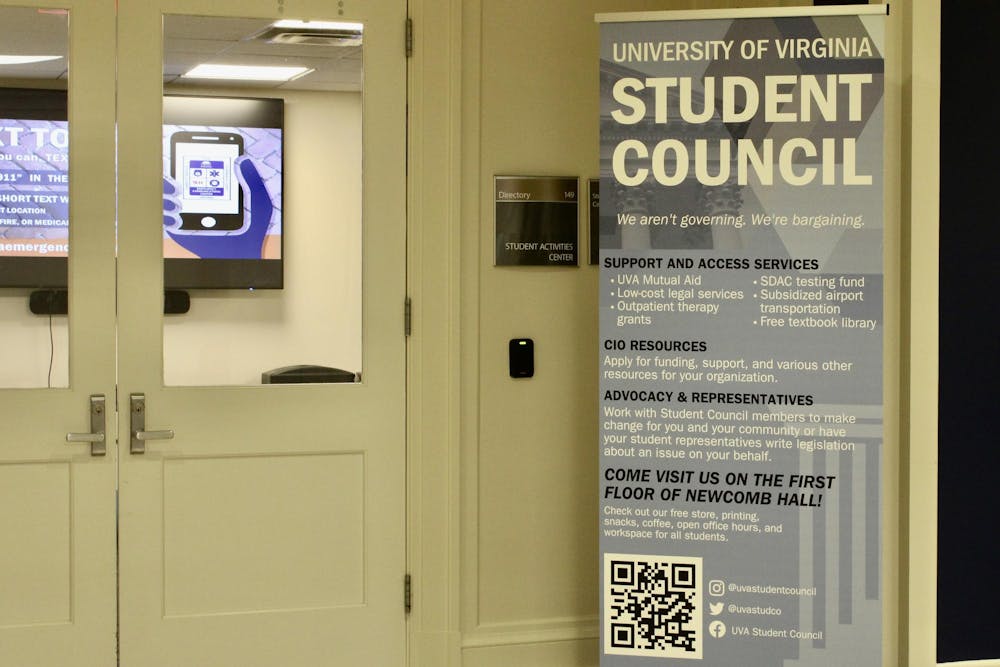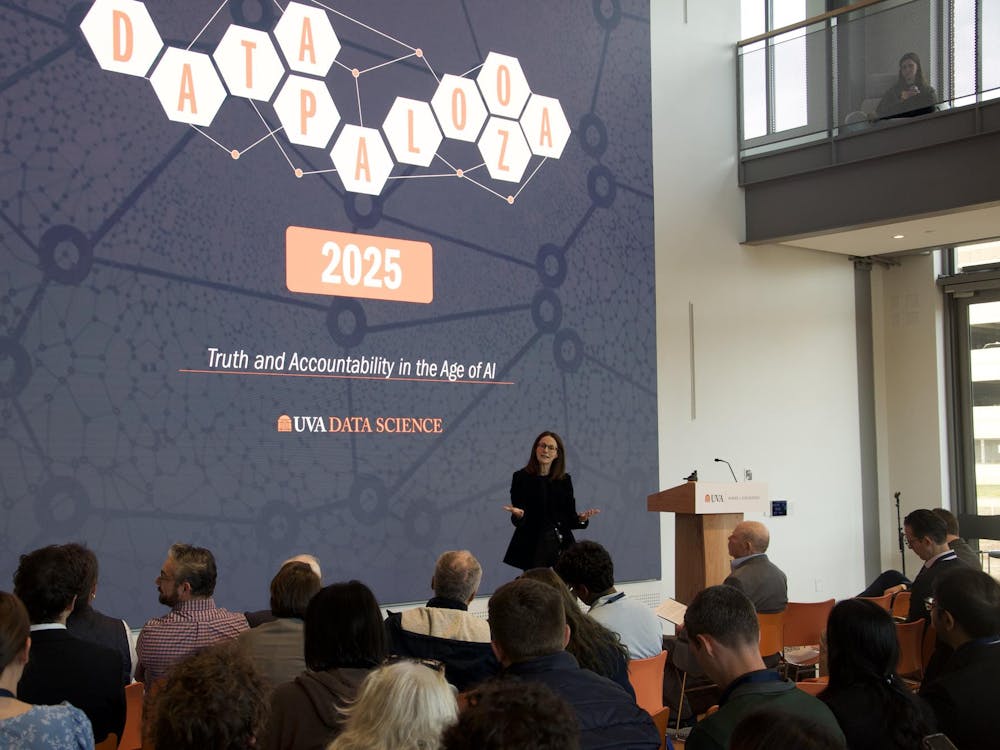Student Council unanimously approved a $271,769.11 budget Sept. 16 for the 2025-26 academic year, an increase of $40,000 from last year. Here’s an in-depth look at where the money came from, and what it is being used for.
Student Council’s budget stems from three sources — the Student Activities Fee, which each student pays with their tuition, Student Council-fundraised money and a gift given to Student Council from former University President Jim Ryan in 2023.
The Student Activities Fee
The SAF cost each University student $58 for the 2025-26 academic year, bringing the total to approximately $1.3 million.
Student Council does not get the entirety of the SAF total, according to Princess Wuraola Olubuse-Omisore, Council vice president for administration and graduate public health student. Part of the $1.3 million is allocated to the salaries of Student Legal Services lawyer Teresa Hepler, a second — currently unknown — salary, Madison House and $91,012.11 for the Student Council internal budget.
Mitchell said the remaining roughly $850,000-900,000 is allocated to Contracted Independent Organizations, so the Council’s Organizations Branch can fund and provide resources to CIOs.
This year, the Organizations Branch had a budget of $41,465 from the SAF, which was unevenly split across its four committees. This includes the CIO Consultants Committee, the Appropriations Committee, the Board of Audit and Management and the Organizations Recognition Committee.
According to Mitchell, the CCC put $40,000 towards granting all CIOs free access to printing and $1,215 to a Mailchimp subscription for the branch to communicate with CIO leaders via email. This CCC budget is approximately $9,000 more than it was for the 2024-25 school year, but Mitchell noted the CCC arrived at a proper budget based on the typical number of pages CIOs have needed to print in years past.
After not receiving funding last year, the final two committees of the Organizations Branch have funding in this year’s budget. The Appropriations Committee has an allocation of $500 which Mitchell said they will use to hold workshops for CIOs to learn about how to make funding requests.
Besides the portion of the SAF budget funding the Organizations Branch, there is an additional $49,547.11 going towards committees outside of the branch. The Arts Agency — a part of the Student Council Presidential Cabinet Agency — has a budget of $20,000 for the 2025-26 year, with a mission to support artists on Grounds.
Non-Student Activities Fee Funding
Non-SAF funding takes the smallest part of Student Council’s budget, with $7,928.50 for the 2025-26 academic year. Wuraola Olubuse-Omisore said during the Student Council general body meeting Sept. 16 that non-SAF funding primarily stems from personal Student Council fundraising, but that fundraising does not regularly occur. Student Council bylaws state that non-SAF funding “shall only be absolutely used when the requests for funds are not SAF-fundable.”
The membership committee takes almost the entirety of the non-SAF funding and is responsible for recruitment and retention of Student Council general members. The committee works to train and plan events for new members, provide stoles to graduating fourth-year students and photograph Student Council member headshots.
The University Allocation
Ryan gifted the Student Council $750,000 in fall 2023 to be split over three years, and in January, Ryan extended this with $250,000 to last another two years. Ryan intended this money to be put towards the Support and Access Services branch of Student Council, the newest branch which provides low-cost services to University students.
The largest part of the 2025-26 budget comes from this University allocation, with a total of $169,528.50 — almost double of the SAS allocation in the 2024-25 Council budget. Funding for SAS uses $145,750.00 of that total, split amongst SAS’s various services. The additional $23,778.50 not being put towards SAS is primarily for Cabinet agencies.
U.Va. Mutual Aid has the largest allocation in the SAS budget, with $63,100.00 for the 2025-26 year. According to Micah Andrews, chief of SAS and third-year College student, it is up to Student Council’s discretion for how much is budgeted of the University allocation per year.
She said Mutual Aid was SAS’s biggest priority this year and has three primary functions. The first is the Cavalier Career Closet, which launched Aug. 26 as a space for University students to take business attire at no cost. The closet required a $20,000 down payment to My Career Closet — the company Student Council is partnering with to receive 140 tailored outfits for students — and is responsible for part of the SAS budget increase.
Two other functions of Mutual Aid are stocking a free store in the Student Activities Center in Newcomb Hall for students to have access to hygiene products and other necessities, as well as providing no-strings-attached grants to students in times of crisis.
The next largest part of the SAS allocation with $40,000.00 is the Accommodations Access Fund, which provides funding to students in need of securing disability confirmation paperwork to receive University disability accommodations.
The AAF funding more than doubled from the 2024-25 year and Andrews said the AAF is now holding Cavalier Health — a new entity Student Council is establishing to hold all health services under one branch. This includes free STI testing for students, which has been held under the Cabinet branch of Student Council in the past. She also said Student Council is re-establishing the Next Steps Fund under Cavalier Health, providing free therapy sessions to students, and finally, Student Council is hoping to add dental insurance under Cavalier Health.
"We're still in the works of figuring [dental insurance] out, but that's what I'm really excited for this year, the expansions of Cavalier Health, as well as seeing Mutual Aid … be utilized,” Andrews said.
Approximately $17,000 of the additional $23,778.50 not being used by SAS is going towards Cabinet agencies in Student Council, including Student Life and Safety and Wellness, which both work to raise student concerns to University administrators.
The Budget Planning Process
Though the Student Council budget is “approved” by a simple vote of aye or nay from Student Council representatives, Mitchell said the planning of the budget begins months in advance and that the budget is not officially approved until it goes through another majority vote among the Student Activities Committee — the committee overseeing the SAF. The Student Activities Committee comprises members appointed by Chief Student Affairs Officer Kenyon Bonner. Wuraola Olubuse-Omisore noted Weider also sits on the committee.
Mitchell explained each committee director within a respective branch of Student Council is tasked with deciding and explaining how much money they would need for the year. This process occurs annually to prevent over-allocation within the budget and Mitchell said the requested budget from each committee is carefully reviewed.
“If this committee requested $20,000 last year and they only spent $1,000, why would we just give them $20,000 again this year?” Mitchell said.
Though not part of a specific branch, Student Council representatives are responsible for advocating for the general University student body and can also request funding. Ian Travis, College representative and third-year College student, said this funding can be used for when representatives pass resolutions to implement projects for improving student life.
However, Travis noted it is hard for representatives — especially new representatives — to think in advance for funding as they may not yet know what projects they will want to initiate until the year progresses.
“I think a lot of reps are still getting their feet on the ground, because we have a lot of new [representatives], and they don't really know what they want to do,” Travis said. “And to get [requested funding] into the budget, you need a fully fleshed out proposal, and sometimes you just can't give it.”
Travis said most representatives rely on requesting money from the budget as the year goes on, rather than putting their requests into the budget upfront.
For the 2025-26 academic year, Mitchell said a goal among Council administrators is to maximize utilization rate — the percentage of the budget actually used at the end of the fiscal year. For the 2024-25 academic year, Council agencies utilized 64 percent of their allocated funding. Mitchell said the goal to increase this rate is because leftover money from the SAF budget returns to the Student Activities Committee, not to the students who pay the SAF.
Though there was an increase in this year’s Council budget, Student Council mainly saw a large shift in their allocations due to removing funding for cosponsorships, rather than increasing the budget for all of their new initiatives. Historically, cosponsorships occurred in which Student Council provided funding to other organizations on Grounds to host events or purchase resources they needed.
Travis emphasized his happiness with the budget planning process this year and said the proposed budget was sent to Council representatives in a respectful manner of time. This allowed representatives to review the proposal and gather any questions or concerns prior to the general body meeting Sept. 16, when the budget went up for a vote to the Reps.
“I’ve been in three budget sessions and I’ve never seen such unanimity [among representatives],” Travis said. “I think Student Council is going to be funded really well going forward with it.”
Council representatives approved the 2025-26 academic year budget at the general body meeting Sept. 16 and Mitchell said this was followed by the Student Activities Committee approving the budget Sept. 18.
This article previously stated that part of the $1.3 million SAF budget goes towards paying the salary of Olga Weider. According to Dickerson, the salaries paid by the SAF include Student Legal Services attorney Teresa Hepler, while the second salary covered is unknown.
This article also previously stated that leftover money in the SAF budget returns to the SAC at the end of the fiscal year, and that the removal of the cosponsorship budget for the 2025-26 academic year caused a shift in the budget allocations. Instead, leftover funds from the SAF budget are allocated to the Student Council’s internal SAF pool of roughly $850,000-$900,000 to be distributed to CIOs, which is also the pool that received the funding in the 2025-26 budget that would have been allocated to cosponsorships.







